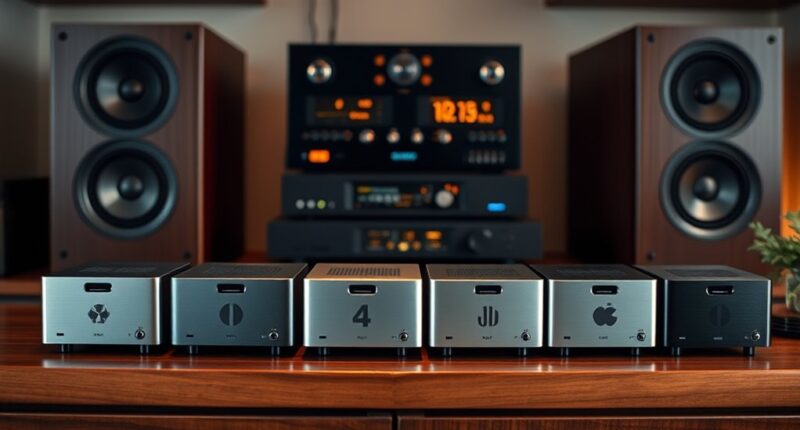For seamless, high-fidelity audio, I recommend considering lossless NAS streamers like the Bluesound Vault 2i, which offers a 2TB drive plus support for multiple formats and streaming services. The WiiM Mini and WiiM Pro are great for multi-room setups with AirPlay 2 and other protocols, while the S.M.S.L DP5SE provides studio-quality sound. The M5 AudioCast delivers versatile wireless streaming, and ELAC’s solution is worth exploring. Keep exploring to find the best fit for your audiophile needs.
Key Takeaways
- Look for models with integrated NAS support like Bluesound Vault 2i for easy large library management.
- Ensure compatibility with high-resolution formats (WAV, FLAC, DSD) for lossless audio playback.
- Opt for devices offering multi-room, multi-zone, and multi-protocol streaming (AirPlay 2, DLNA, Roon).
- Consider units with robust connectivity options, including Ethernet, WiFi, and USB/NAS ports.
- Prioritize brands with reliable performance and user reviews, noting potential setup or support issues.
WiiM Mini AirPlay 2 Wireless Audio Streamer

If you’re looking to upgrade your vintage or multi-room audio system with high-resolution, lossless sound, the WiiM Mini AirPlay 2 Wireless Audio Streamer is an excellent choice. It transforms any stereo into an AirPlay 2-enabled speaker, allowing seamless streaming from iOS, Mac devices, and Apple TV. Compatible with Alexa and Siri, it supports multiroom setups for synchronized playback across multiple devices. The streamer delivers studio-quality sound up to 192kHz, 24-bit, with gapless playback for high-res services like TIDAL and Amazon Music. Its compact size and easy setup make it perfect for enhancing legacy systems or creating a flexible, high-fidelity home audio experience.
Best For: audiophiles and home entertainment enthusiasts looking to upgrade vintage or multi-room audio systems with high-resolution, lossless streaming capabilities.
Pros:
- Supports high-fidelity audio up to 192kHz, 24-bit for studio-quality sound
- Compatible with multiple voice assistants like Alexa and Siri for easy voice control
- Enables multiroom synchronized playback with AirPlay 2, Alexa, or multiple WiiM units
Cons:
- Cannot transmit AirPlay signals to other speakers, as it is receiver-only
- Lacks Google Cast support, limiting cross-platform compatibility
- All-black connectors can make distinguishing left/right channels difficult, though easily remedied
WiiM Pro AirPlay 2 Receiver, Google Cast Audio, WiFi Streamer

The WiiM Pro AirPlay 2 Receiver, Google Cast Audio, WiFi Streamer is an excellent choice for audiophiles and home theater enthusiasts who want high-fidelity, multiroom streaming without relying on Bluetooth. It seamlessly connects with iOS, Mac, and Android devices, supporting popular apps like Spotify, TIDAL, and Amazon Music. With support for hi-res audio up to 24-bit/192 kHz via optical or coax, it guarantees premium sound quality. Its multiroom capabilities allow synchronized playback across rooms, while voice control through Alexa, Google Assistant, or Siri adds convenience. Designed solely as a receiver, it expands existing setups, delivering reliable, high-quality wireless streaming.
Best For: audiophiles and home theater enthusiasts seeking high-fidelity, multiroom wireless streaming without relying on Bluetooth.
Pros:
- Supports high-resolution audio up to 24-bit/192 kHz via optical or coax outputs for premium sound quality
- Compatible with a wide range of streaming apps including Spotify, TIDAL, and Amazon Music, with multiroom and group playback capabilities
- Allows control through voice assistants like Alexa, Google Assistant, and Siri for added convenience
Cons:
- Functions solely as an AirPlay 2 receiver and cannot transmit AirPlay streams to other speakers
- Limited to receiving streams; not suitable for broadcasting or transmitting AirPlay signals to multiple devices
- Does not support Bluetooth, which may be a drawback for users relying on Bluetooth connectivity
M5 AudioCast HiFi Music Receiver with WiFi and Multi-Room Support
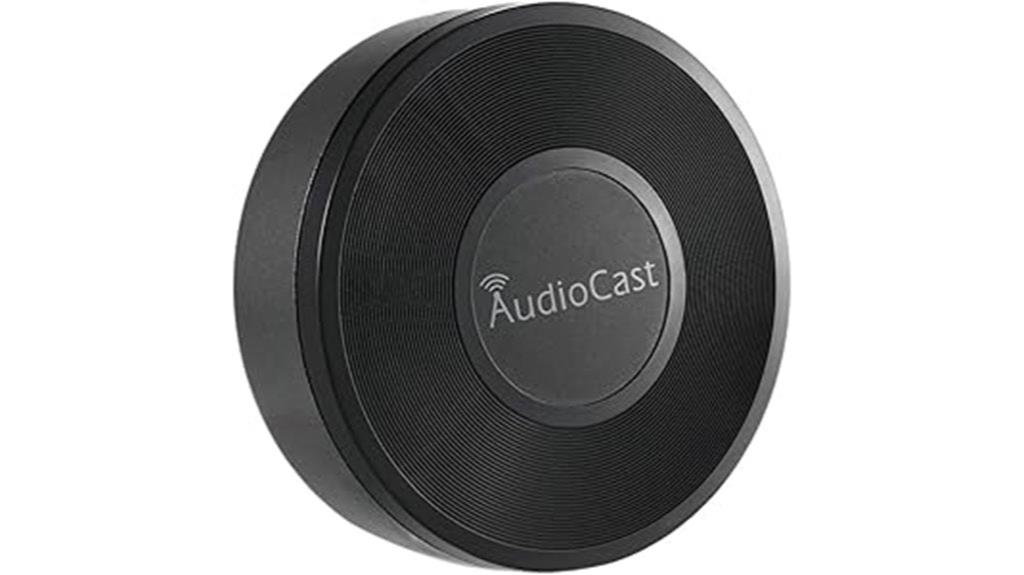
For anyone looking to transform their existing speakers into a smart, multi-room audio system, the M5 AudioCast HiFi Music Receiver offers an excellent solution. It streams high-definition HiFi music via WiFi and supports protocols like AirPlay, DLNA, and Airmusic, making it compatible with iOS and Android devices. You can wirelessly stream from your smartphone, tablet, or laptop, and enjoy both local and online services such as Spotify and Pandora. With support for up to 8 rooms, you can synchronize playback or play different songs across zones, all controlled through a single app. Its compact size and stable WiFi connectivity make it a versatile, user-friendly addition to any home audio setup.
Best For: Homeowners and audiophiles wanting to upgrade their existing speakers into a multi-room, wireless high-fidelity audio system that supports various streaming protocols and easy app control.
Pros:
- Supports multiple protocols like AirPlay, DLNA, and Airmusic for broad device compatibility
- Enables multi-room synchronized playback across up to 8 zones for versatile listening options
- Compact and lightweight design for easy integration and portability
Cons:
- Customer reviews indicate an average rating of 3.2 out of 5 stars, suggesting mixed experiences
- Web console connection may have compatibility issues with certain devices
- Limited information on advanced features or customization options beyond basic multi-room streaming
S.M.S.L DP5SE High-Resolution WiFi Network Audio Player and Streamer
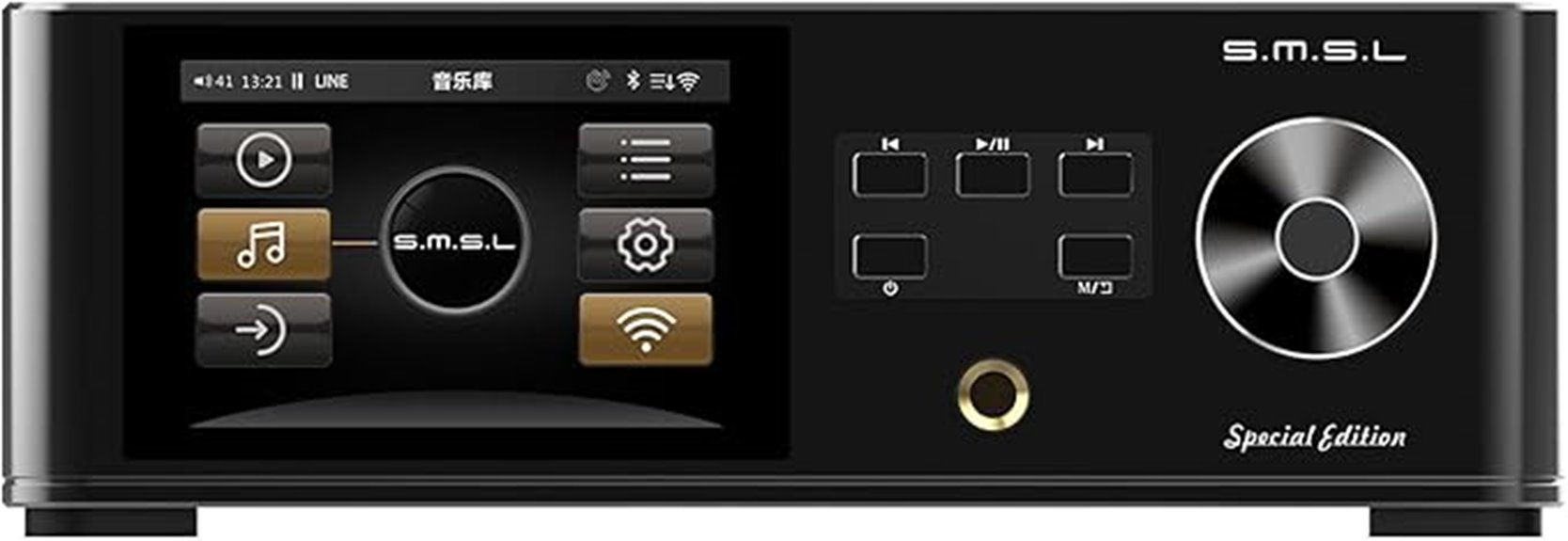
Audiophiles seeking pristine, lossless sound will find the S.M.S.L DP5SE an excellent choice, thanks to its high-resolution WiFi streaming capabilities and ES9039Q2M D/A chip. It delivers clear, noise-free audio with high SNR and low distortion, supporting formats like DSD, WAV, FLAC, and more. With both wireless and wired connections—including NAS, external drives, and mobile devices—it offers versatile compatibility. Features like Bluetooth, DLNA, and AirPlay ensure seamless streaming. Compact yet powerful, the DP5SE is ideal for anyone wanting high-fidelity, lossless music playback in a flexible, user-friendly package.
Best For: audiophiles and music enthusiasts seeking high-resolution, lossless streaming with versatile connectivity options for superior sound quality.
Pros:
- Supports a wide range of high-resolution audio formats including DSD, WAV, FLAC, and more for true lossless playback
- Equipped with advanced ES9039Q2M D/A chip for high SNR and low distortion audio quality
- Offers flexible connectivity options including WiFi, Ethernet, Bluetooth, DLNA, AirPlay, and multiple output interfaces
Cons:
- Customer ratings are moderate, with some users indicating room for improvement in user interface or setup
- Limited information on app control or firmware update procedures in the available details
- Size and weight may be less portable compared to smaller, less feature-rich streaming devices
Bluesound Vault 2i High-Res 2TB Network Hard Drive CD Ripper and Streamer
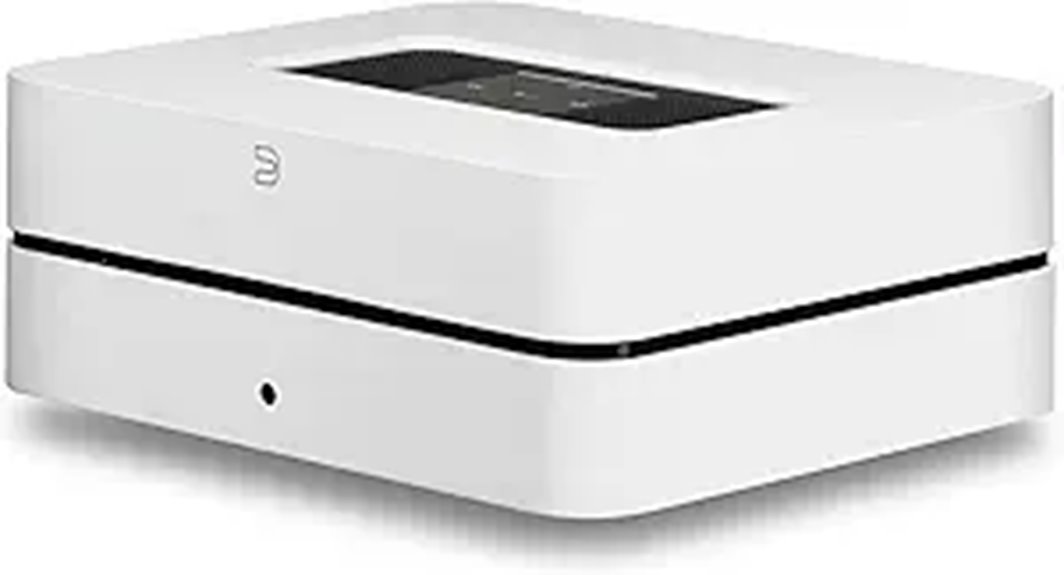
If you’re looking for a reliable way to rip, store, and stream a large CD collection seamlessly, the Bluesound Vault 2i stands out with its 2TB high-resolution network hard drive. It supports ripping CDs into multiple formats like FLAC, WAV, MP3, and WMA, with storage for up to 30,000 tracks. The device doubles as a NAS and offers streaming to Bluesound speakers, plus Apple AirPlay, Alexa, and Siri compatibility. However, setup can be tricky, ripping is sometimes slow, and network issues may occur. Customer feedback is mixed, highlighting reliability and support concerns, but it remains a solid option for those seeking integrated storage and streaming.
Best For: audiophiles and home music enthusiasts seeking an all-in-one solution for ripping, storing, and streaming large CD collections with high-resolution audio quality.
Pros:
- Supports multiple audio formats including high-resolution FLAC, WAV, MP3, and WMA for versatile listening options
- Acts as both a networked hard drive and NAS, allowing easy access and sharing across devices
- Integrates with popular streaming services and voice assistants like Alexa and Siri for convenient control
Cons:
- Ripping process can be slow, taking approximately 15-20 minutes per CD, with occasional errors or slot issues
- Setup and network connectivity can be complicated, especially without a wired Ethernet connection, leading to frustration
- Customer support and documentation have been inconsistent, with reports of poor service and unresolved technical issues
ELAC Discovery Music Server
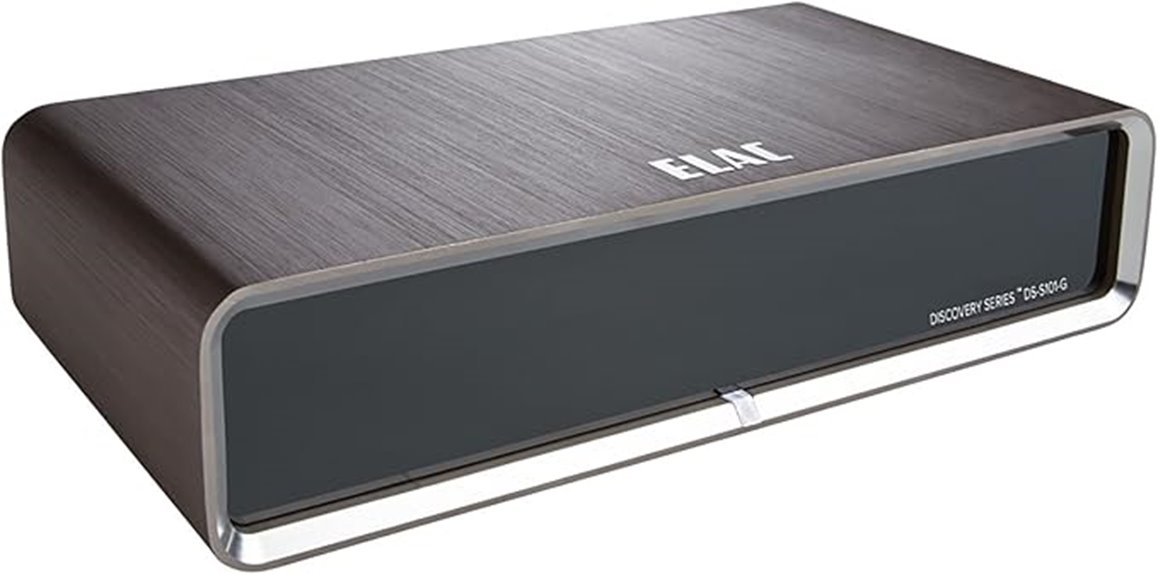
The ELAC Discovery Music Server is an excellent choice for anyone seeking a streamlined, all-in-one digital audio solution without the need for a computer. It automatically organizes your music with rich metadata and supports high-resolution formats like WAV, FLAC, ALAC, and AIFF up to 24-bit/192kHz. With multi-room and synchronized playback, you can enjoy your music throughout your home effortlessly. The intuitive Room Essentials interface and compatible apps on iOS, Android, Windows, and macOS make control simple. Featuring various outputs, streaming services like Tidal, and seamless integration as an endpoint, it’s a versatile, compact, and user-friendly option for high-fidelity audio enthusiasts.
Best For: audiophiles and home music enthusiasts seeking an all-in-one, high-resolution digital music solution with multi-room capabilities and easy control.
Pros:
- Supports a wide range of high-resolution audio formats up to 24-bit/192kHz, ensuring premium sound quality
- Intuitive Room Essentials interface and compatibility with iOS, Android, Windows, and macOS apps for simple control
- Seamless integration with streaming services like Tidal and multi-room audio for versatile listening options
Cons:
- Customer ratings average only 3.9 out of 5 stars, indicating mixed user experiences
- Limited to a track limit of 15,000 on Tidal content, which may be restrictive for large libraries
- Does not include built-in Wi-Fi, relying on wired Ethernet or optional external adapters for network connectivity
Factors to Consider When Choosing Lossless Home NAS Streamers

When selecting a lossless home NAS streamer, I focus on compatibility with different formats and streaming protocols to guarantee seamless playback. I also consider how easy it is to set up and connect, especially if I want multi-room capabilities. Finally, I look at build quality and reliability to guarantee long-term performance and minimal interruptions.
Compatibility and Formats
Choosing a lossless home NAS streamer requires guaranteeing it supports the high-resolution audio formats you prefer, such as WAV, FLAC, ALAC, or DSD, to maintain the integrity of your music. Compatibility with multiple streaming protocols—like AirPlay, DLNA, AirMusic, and Chromecast—is essential for flexible device integration. You should also verify that the device can handle your desired bit depth and sampling rates, typically up to 24-bit/192kHz, for true high-fidelity playback. Additionally, support for popular online music services and local media libraries, including formats like MP3, AAC, OGG, and WMA, provides versatile streaming options. Ultimately, seamless compatibility with your existing network and audio components ensures stable, lossless playback without interruptions or quality loss.
Streaming Protocols Supported
Selecting a lossless home NAS streamer means ensuring it supports the right streaming protocols to match your devices and listening preferences. Protocols like DLNA facilitate high-resolution audio streaming over local networks to compatible devices, maintaining exemplary fidelity. AirPlay, including AirPlay 2, offers seamless wireless streaming from Apple devices, with multiroom and synchronized playback features ideal for integrated setups. UPnP provides flexible, open standards for streaming high-quality audio from your NAS to a wide range of compatible players and apps, giving you versatility. Additionally, support for advanced protocols like Roon enhances your experience with rich metadata, multiroom management, and refined control, making it perfect for audiophiles seeking a customizable, high-fidelity listening environment. Compatibility across these protocols is key for a seamless, versatile streaming experience.
Connection and Setup Ease
Ensuring your lossless home NAS streamer is easy to set up can save you time and frustration. Look for models with straightforward setup options like plug-and-play Ethernet or WiFi connections, so you don’t have to wrestle with complicated configurations. Compatibility with your existing network, including support for both 2.4GHz and 5GHz WiFi bands, ensures flexible and reliable connectivity. Devices with intuitive mobile apps or web interfaces make configuration accessible, even if you’re not a tech expert. Support for multiple connection methods—wired Ethernet, WiFi, USB, or digital outputs—adds versatility to suit different home environments. Clear indicator lights, status displays, or automated detection features help verify successful connections quickly, making setup smooth and hassle-free from the start.
Multi-Room Capabilities
Multi-room capabilities are essential for creating a cohesive listening experience throughout your home, so it’s important to contemplate how well a NAS streamer can support multiple zones. A good system should enable synchronized playback across various speakers or rooms, giving you seamless audio everywhere. Many NAS streamers support protocols like AirPlay 2, Google Cast, or proprietary solutions, allowing flexible grouping of devices. Centralized control through a single app simplifies managing volume, playlists, and device groups. Some systems even support multi-source playback, letting different rooms play distinct music or the same playlist simultaneously. However, reliable multi-room streaming hinges on a stable WiFi or wired network, ensuring minimal latency and perfect synchronization. Choosing a system with strong multi-room features enhances your overall listening experience.
Build Quality and Reliability
When choosing a lossless home NAS streamer, build quality and reliability are crucial factors that directly impact long-term performance. A sturdy build with high-quality materials reduces the risk of hardware failures and ensures the device lasts over time. Reliable streamers incorporate robust internal components, such as industrial-grade capacitors and efficient heatsinks, to maintain stable operation during continuous use. Solid construction also minimizes vibrations and interference, which can affect audio quality or cause connection issues. Proper ventilation in a well-designed chassis prevents overheating, protecting internal parts from degradation and avoiding shutdowns. Additionally, consistent manufacturing standards and strict quality control processes lead to dependable performance and fewer hardware malfunctions, giving you peace of mind that your investment will provide seamless, high-fidelity audio for years to come.
Frequently Asked Questions
How Do Lossless Streamers Handle Network Interruptions During Playback?
Lossless streamers handle network interruptions by buffering data, allowing playback to continue smoothly while the connection stabilizes. I’ve noticed that many models automatically pause and resume once the network recovers, minimizing disruptions. Some even prioritize maintaining audio quality over speed, which helps prevent artifacts during brief interruptions. Overall, these streamers are designed to be resilient, so I hardly notice any issues unless the network issues are prolonged or severe.
Can These Streamers Integrate With Existing Home Automation Systems?
Absolutely, these streamers can integrate with your home automation system, and it’s often quite seamless. I’ve found that many support popular platforms like Alexa, Google Assistant, or Apple HomeKit, allowing me to control my music with simple voice commands or automation routines. While setup might sometimes require a bit of tinkering, once connected, it transforms your entire home into a high-fidelity audio haven, making every song feel more alive.
What Is the Typical Setup Process for a Lossless Home NAS Streamer?
Setting up a lossless home NAS streamer is straightforward. I start by connecting the device to my network via Ethernet or Wi-Fi. Then, I access its web interface to configure network settings and link my NAS storage. After that, I install the companion app or software on my control device, like a smartphone or tablet. Finally, I browse my music library, select tracks, and enjoy seamless, high-quality audio streaming.
Are Firmware Updates Necessary for Optimal Performance and Security?
Yes, firmware updates are crucial for peak performance and security. They often fix bugs, improve stability, and add new features that enhance your listening experience. I make it a habit to check for updates regularly and install them promptly. Keeping your NAS streamer’s firmware current ensures smooth operation, protects your system from vulnerabilities, and guarantees you enjoy high-fidelity audio without interruptions or security concerns.
How Do These Devices Compare in Terms of Energy Consumption?
These devices vary in energy consumption depending on their design and usage. I’ve found that newer models tend to be more energy-efficient, consuming less power during streaming and idle times. Some NAS streamers have power-saving modes, which help reduce overall energy use. I always check their specifications for wattage and energy ratings before choosing one, so I know I’m getting a device that’s both high-quality and eco-friendly.
Conclusion
Choosing the right lossless home NAS streamer can truly elevate your listening experience, but the perfect match depends on your specific needs. Will you prioritize multi-room support, high-res playback, or seamless integration? With so many options, it’s easy to feel overwhelmed. But don’t worry—dive deeper into each device’s features, and you’ll uncover the one that can transform your audio setup into a high-fidelity haven. The next step could change everything—are you ready to discover which one?
